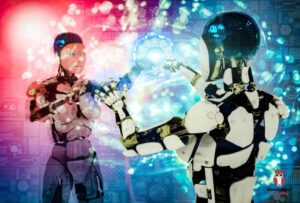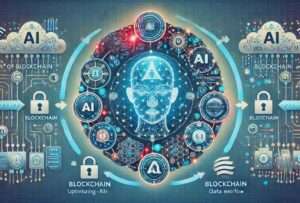Hey. It’s so good to be back. I took a short break from writing and teaching. Needed that break. Phew! I’ve taken time to research and put this article together, so thank you for reading. Many have been asking me to shed some light on this topic on Ai and Blockhain Integration, so here you go.
Ever feel like the digital world is whizzing past us at warp speed? One minute we’re marvelling at the internet, the next we’re diving headfirst into Web3, decentralized IDs and Quantum-resistant cryptography. OMG! If you’re seeing what I’m seeing.
Honestly, nowhere is this breath-taking pace more evident than at that fascinating intersection of blockchain, Artificial Intelligence, and our inherent human quest for true digital ownership. You know, that feeling of truly owning your online self, rather than being just another data point.
While we’ve all been buzzing about the individual potential of blockchain (think decentralization and trust, right?) and AI (hello, intelligence and automation!), 2025 isn’t just about their individual prowess anymore. Oh no, my friend, this year marks a pivotal shift: their profound, seamless integration.
For a long time, the big challenge, the elephant in the room if you will, was how to truly bridge these two powerful forces without compromising what makes each of them so special. How do we get AI to play nicely with blockchain’s core principles of immutability and decentralization? And vice-versa?
Well, I’m here to tell you that the solutions aren’t just emerging; they’re blossoming! We’re looking at a future where AI isn’t just a fancy add-on; in fact, it actively enhances blockchain’s security and efficiency. And blockchain? It’s becoming the unshakeable bedrock of trust for AI’s operations, especially in that rapidly growing realm of decentralized identity. Sounds exciting, doesn’t it?
Tangible AI & Blockchain Integration Applications in 2025
You know, for years, the chatter around AI and blockchain integration felt a bit… theoretical. Lots of “what ifs” and “could be’s.” But let me tell you, as we step deeper into 2025, we’re moving decidedly beyond theory. Indeed, we’re seeing tangible applications take root, and it’s exhilarating!
Imagine this: AI-powered smart contracts, not just static lines of code, but dynamic, intelligent agreements that can actually learn and adapt. Or predictive analytics that foresee potential issues before they even arise, embedded directly into our blockchain ecosystems. Furthermore, let’s not forget fraud detection capabilities that are so sophisticated, they make traditional systems look like quaint relics.
These aren’t just futuristic concepts anymore. On the contrary, they are fundamentally reshaping how you and I interact with our digital assets and, crucially, how we verify our identities online. This isn’t merely about making things more efficient (though that’s a huge bonus, of course!); rather, it’s about building a digital future that is inherently more secure, wonderfully transparent, and deeply user-centric.
So, let’s unpack a few of these game-changers, shall we?
AI-Powered Smart Contracts: A Key to Blockchain Integration
Ai and Blockchain integration at its core. Here’s how this will work. Think of a traditional smart contract as a highly obedient, albeit rigid, robot. It executes commands precisely as programmed. Now, inject a dose of AI into that robot, and what do you get? A smart contract that can learn, adapt, and even make informed decisions based on real-time data!
AI can empower these contracts to be far more dynamic and self-adjusting. They can respond to live market conditions, react to external data feeds (like weather patterns, news events, or even social sentiment), and execute terms with an intelligence that was previously impossible.
A Practical Glimpse of Ai and Blockchain Integration
- Automated Insurance Payouts: Imagine flight delay insurance. Instead of filling out forms and waiting for claims to be processed, AI analyzes verifiable flight data (delay times, reasons, etc.) on a blockchain. Consequently, if the conditions are met, the smart contract, powered by AI’s analysis, automatically triggers your payout. No human intervention needed! It’s efficient, unbiased, and incredibly fast.
- Supply Chain Optimization: Consider a smart contract that manages a fresh produce delivery. AI could monitor temperature sensors (IoT data) along the supply chain. If temperatures exceed a certain threshold (detected by AI’s analysis), then the smart contract could automatically adjust payment terms or even re-route the shipment, all recorded transparently on the blockchain.
My Take on the Impact: This is far from just my opinion, and industry leaders are echoing this sentiment. The impact is profound. It drastically reduces human intervention, leading to staggering increases in efficiency and a significant minimization of potential errors. The financial industry, in particular, is already undergoing a fascinating shift, a quiet revolution towards a more inclusive Web3 experience, powered by these intelligent apps and predictive analytics. Truly, a more automated, fairer financial landscape is just a stone’s throw away!
Leveraging Blockchain as the Trust Layer for AI Integration
As AI weaves itself deeper into the fabric of our daily lives, from our smart home devices to critical infrastructure, one question looms large: Can we trust it? Ensuring the integrity of AI’s data inputs (what it learns from) and its outputs (what it tells us) is absolutely critical. This is precisely where blockchain steps in, like a steadfast guardian.
Blockchain’s immutable, transparent ledger provides an auditable, tamper-proof trail for AI models and, crucially, their training data. Think of it as a digital notary public for every piece of information AI interacts with.
Ai and Blockchain Integration Real-World Scenarios
- Verifying AI-Generated Content (Combating Deepfakes!): With generative AI systems like ChatGPT, Gemini, and others (the list seems to grow daily, doesn’t it?), the ability to create hyper-realistic images, videos, and audio is astounding. But how do we know what’s real and what’s a “deepfake”? Blockchain can record the provenance of AI-generated content, creating a verifiable timestamp and signature. If content lacks this blockchain attestation, then you’ll have a strong reason to question its authenticity. This is vital for news, media, and even legal evidence. You can delve deeper into the challenges and solutions around data integrity in AI and blockchain in this insightful research paper on Data Privacy Challenges in Blockchain and AI Technologies.
- Ethical AI in Supply Chains: Imagine AI optimizing a complex supply chain. Blockchain can track every data point the AI uses, from source materials to delivery. This ensures not only efficiency but also verifies ethical sourcing, fair labour practices, and environmental compliance, making the AI’s “decisions” fully accountable.
The Bottom Line Impact: Ultimately, this enhances transparency and accountability across all AI applications. It’s our best weapon in the fight against misinformation, deepfakes, and insidious data manipulation. It gives us a way to verify the intelligence we increasingly rely on.
AI & Decentralized Identity Integration
Here’s a concept that truly excites me: Decentralized Identity (DID). This isn’t just about convenience; it’s fundamentally about giving you, the individual, self-sovereign control over your own digital identity. No more relying on big tech companies to hold all your sensitive data in centralized honey pots, just waiting to be hacked!
AI, in this context, isn’t just a supporting player; it’s a crucial enabler, enhancing both the security and the sheer usability of DID systems.
How AI Supercharges DID
- Robust Security: AI-driven facial recognition, biometric verification (like fingerprint or iris scans), or even advanced behavioral analytics can strengthen the security of accessing your DID credentials. The beauty here is that these powerful security checks happen without your sensitive biometric data ever leaving your device or being controlled by a central entity. It’s about you proving who you are, securely, to the blockchain, not handing over your keys to a third party.
- Proactive Fraud Detection: AI-powered algorithms can constantly monitor for suspicious patterns or anomalies associated with identity usage, acting as an early warning system against identity theft. Imagine your DID system flagging unusual login attempts or transactions, instantly alerting you and initiating protective measures.
The Tangible Impact for You: As a result, the risk of identity theft and data breaches is significantly reduced. Your most sensitive information is truly under your control, securely encrypted on a blockchain, not floating around in corporate databases vulnerable to attack. This empowers you, the user, in a way we’ve only dreamed of before.
Navigating AI and Blockchain Integration Challenges
While the promise of this AI-blockchain convergence is undeniably significant, let’s be pragmatic for a moment. Challenges remain, particularly in achieving truly seamless interoperability between the myriad of AI systems out there and the diverse landscape of blockchain networks. We’re still in the early innings, my friends.
Yes, it’s true: modern blockchains, especially public ones, are incredibly difficult – often nearly impossible – to hack today. They are built with layers of cryptographic security that are truly astounding. But tomorrow? Well, we never know. This is why the conversation around quantum-resistant cryptography is gaining so much traction.
Speaking of progress, we must take a moment to appreciate the incredible strides made in building Generative AI models. Whether it’s ChatGPT, Google’s Gemini (yes, that’s me!), Microsoft’s Co-pilot, or countless others whose names are probably blurring into one fantastic innovation blob, these are monumental achievements. They are changing how we work, create, and interact with information.
However, a major area of concern – and one that we, as individuals, must hold dear – will always be Data Privacy. For organizations, the promise of efficiency and new capabilities is compelling, but for us, the users, it’s absolutely imperative that implementing and creating these various AI touch points doesn’t take away our fundamental rights to data privacy. We need to ensure that the tools built to serve us don’t inadvertently expose or exploit our personal information. This is a delicate balance, and one we must actively champion.
Governing AI and Blockchain Integration
It’s not just individuals and tech companies thinking about these issues. Governments and major organizations are already recognizing the future challenges. For instance, in anticipation of potential threats from quantum computing, government agencies are being strongly encouraged to migrate to quantum-resistant cryptographic methods as soon as possible. This isn’t a “maybe someday” plan; on the contrary, it’s happening now.
For a crucial read on this, I highly recommend checking out the joint fact sheet from the Cybersecurity and Infrastructure Security Agency (CISA), NSA, and NIST. It’s designed to help organizations understand the significant impact of quantum capabilities and, more importantly, how to plan for this critical transition. It’s a bit technical, but if you’re serious about the future of secure digital systems, it’s absolutely worth your time. You can find their official guidance on preparing for the quantum threat on the NIST website.
The Future of Seamless AI and Blockchain Integration
So, what does the crystal ball show for this incredible convergence? My bet is that this integration of AI and blockchain will be the primary driver of next-generation automation and security.
Expect to see even more sophisticated quantum-resistant blockchain solutions emerging, specifically designed to protect your digital assets from future threats, even from the most powerful supercomputers. The focus isn’t just on current security, but rather on future-proofing our digital lives.
We are actively laying the foundation for a truly decentralized and intelligent web – a Web3 that is not only smart but also inherently secure and puts you firmly in control. It’s a future where your digital self is truly yours, powered by an invisible dance between AI’s intelligence and blockchain’s trust.
Tell Me Your Thoughts!
I’ve shared my insights, but what do you think?
- How do you envision the future of blockchain and AI together?
- Do you believe they will eventually integrate and become truly seamless, like two parts of a single, powerful engine?
- Where do you foresee the most significant impact on our daily lives or on global industries?
Share your thoughts and perspectives in the comments below! Let’s continue this vital conversation.
- Seizing Phuket Web3 Smart City Opportunities: A Guide for Tech Innovators - August 5, 2025
- AI & Blockchain Integration: 2025’s Digital Future - July 18, 2025
- Ai, Fintech and Blockchain Adoption: Malaysia vs Indonesia - October 11, 2024


